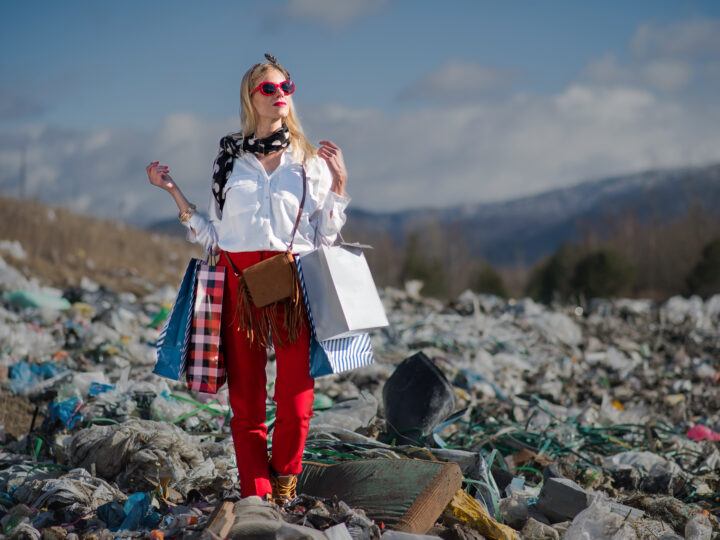Fashion is a powerful thing. It allows us to express ourselves, to reinvent ourselves, and to make a statement about who we are and who we want to be perceived as.
“As soon as man emerged from the cave, clothes took on a social significance,” says Robin Givhan, Pulitzer prize-winning fashion writer. “I don’t think there’s ever been a period where a shirt was just a shirt!”
So, if fashion is such a key part of our identity and our culture, what does the phenomenon of fast fashion say about us? And what are the advantages and disadvantages of fast fashion?

Table of Contents
What Does Fast Fashion Mean?
The history of fast fashion first began with a business model that was developed by Amancio Ortega, the founder of Zara. Rather than creating designs and investing in huge production runs for each season, he would design all year round and produce clothing lines in smaller volumes that never went on sale.
The process of going from runway to the store was fast, the rotation of new styles was fast, and customers had to be fast to make purchases before the limited supply of designs were sold out.
Nowadays, the model has been adopted by almost every high street store, and the definition of fast fashion has expanded to mean the fast nature in which low-quality items are not only produced and sold, but are also discarded.
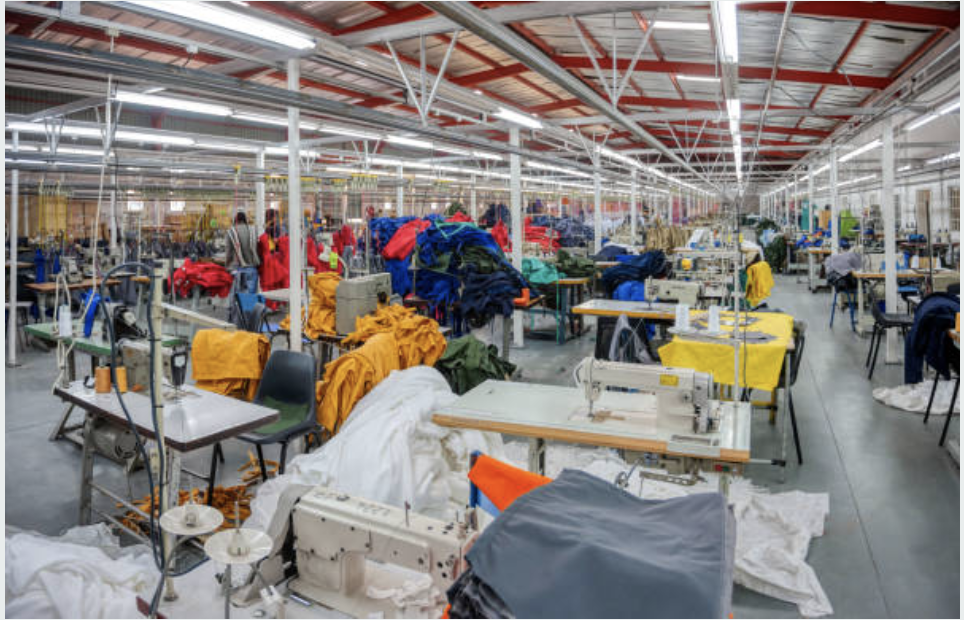
Related Reading: Best Books on Sustainable Fashion
What is the problem with fast fashion?
The concept of fast fashion is to generate profit margins by producing cheap clothes in volume. When the production is amped up in this way, negative effects associated with the supply chain are also amplified. This includes both the environmental impact and the social impacts of fast fashion.
Not only is volume an issue. The ‘takeover’ of fast fashion in the clothing industry is also creating new, emergent problems.
There’s a high cost of fast fashion, and it’s not always immediately obvious who is paying.
The fast fashion environmental impact is higher
It might surprise you to know that the clothing industry contributes to around 8% of global climate impact.
And that the carbon emissions from the average person’s annual clothing consumption are the equivalent of taking a 4,100 km flight. The next holiday that you take might well be harming the planet more with what you pack in your suitcase than with your actual transport.
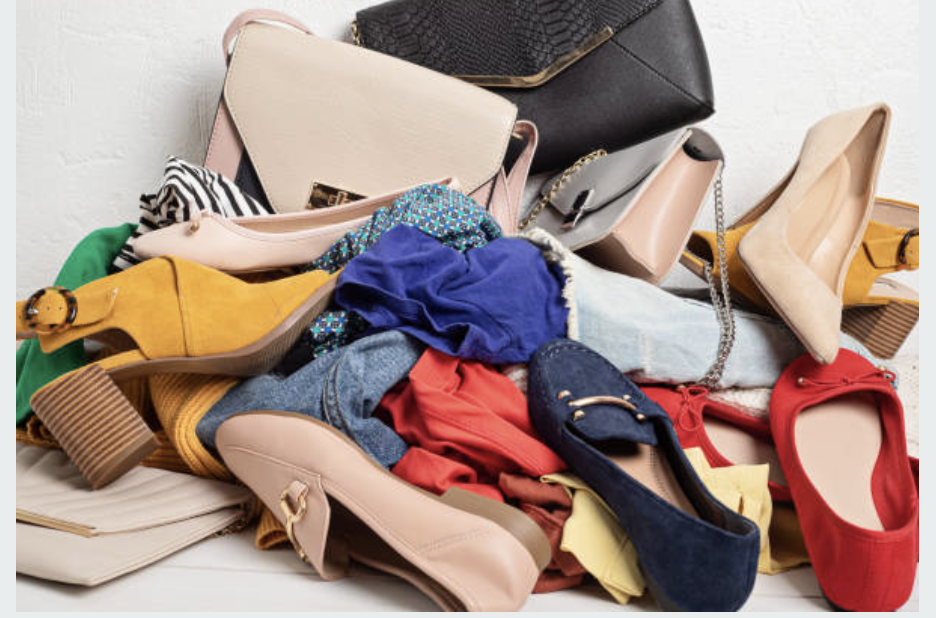
Fossil fuel energy use, freshwater, the consumption of finite resources, and the impact on human health all contribute to the negative environmental impact of fast fashion. The most significant contributions are from the production and preparation of textiles, and the dyeing and finishing stages, with distribution and disposal having relatively little impact.
Because the fast fashion concept is based on the ability to produce items at volume, it directly contributes to increasing emissions. Clothing production has doubled over the last 15 years and, with the rise of fast fashion, the trend shows no sign of slowing.
It is estimated that by 2050, our clothing will take up over a quarter of a 2-degree pathway carbon budget.
Fast fashion creates a waste problem
The cycle of buying low-quality clothes that are then quickly discarded as they wear out or become ‘unfashionable’ generates a large amount of waste. According to the sustainable living documentary, The True Cost, the average American gets rid of around 37 kg of clothes each year. A whopping 97% of clothing is made with virgin material, and very little is recycled or reused with 73% of used clothes going to landfill.
Many cheap clothes are made from, or contain at least some synthetic fibers which take thousands of years to break down. Even natural fibers produce methane if they decompose in a landfill, under anaerobic conditions (meaning without oxygen).

Recycling is also more difficult. Clothing in general is a challenge to recycle as it is made from mixtures of materials that are labor intensive and complex to sort. Not only do buttons and elastic waistbands need to be separated, but each type of fabric needs to be identified and sorted.
Additionally, the shorter fiber lengths in cheap fabrics mean that they often cannot be recycled into new clothes, and instead go to make lower-value products such as cleaning cloths and stuffing. All of this raises the cost and reduces the benefits of recycling fast fashion products.
The low quality of fast fashion clothes also means that many garments can’t be reused. Even if they are made available, the pace of trends mean that customers are less willing to buy them as they become outdated. Vintage items that hold their value and are iconic of their era are no more.
The use of harmful chemicals is increasing
Chemicals are used throughout the clothing life cycle, from fabric production, to treatment, through to their use as they are washed. The more clothing items that are produced, the more chemicals that are used in the process.
Synthetic fabrics are derived chemically from petroleum, but natural textiles such as cotton also tend to be produced using unsustainable methods. They use huge quantities of fresh water and pesticides, which are often washed into the waterways and cause more widespread effects.
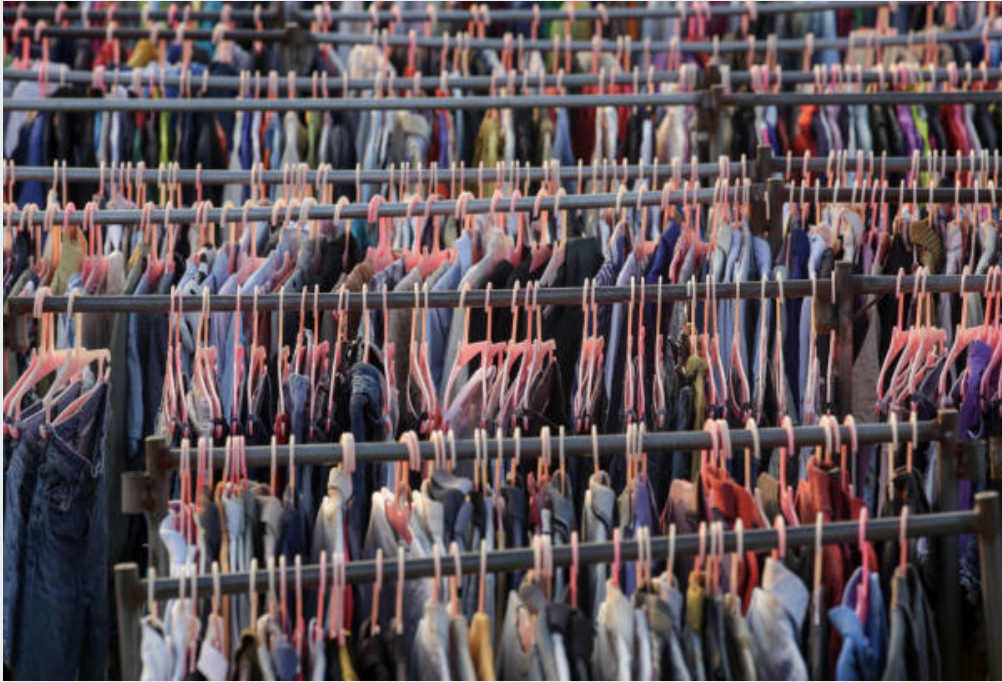
Chemicals are also used extensively in the dyeing process, not only to achieve color but also to bond the color to the fabric. You might be put off from having your skin in contact with these chemicals, but during production, they can enter the water system and workers can be chronically exposed to high concentrations of harmful products.
The list includes heavy metals, chlorinated solvents, phthalates found in flexible plastic components, perfluorinated chemicals for water repellent properties, and formaldehyde.
Synthetic materials also shed microplastics during the wash cycle, which releases toxins into the environment and accumulate in ecosystems, eventually ending up in the human food chain. It is estimated that half a million tonnes of plastic microfibers end up in the ocean every year from washing clothes.
Cheap clothes need cheap labor
Cheap products not only use cheap textiles, they also need to be cheap to produce. This means that the laborers that work to produce clothes are paid less.
Most clothes are made in low wage countries – the majority are made in China, Turkey, Bangladesh, and India – where even the official minimum wages (just $92 per month in Bangladesh for example) are often not actually paid. Safety regulations are also not as tightly upheld. In 2013, an eight-floor factory building in Dhaka, Bangladesh collapsed killing 1,134 workers and injuring thousands more.
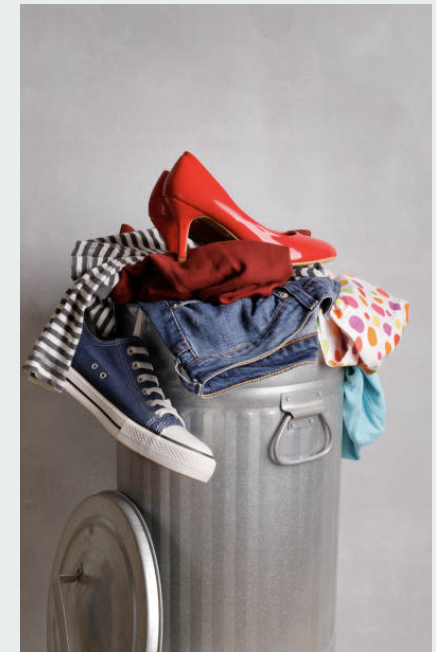
Many workers in the clothing industry are children, with the International Labour Organization estimating that 11% of the world’s children cannot go to school without needing to participate in some form of work. And don’t just think of sweatshops. In the cotton industry, children are often employed to transfer pollen from one plant to another and work in the ginning factories (where the raw cotton is processed).
Fast fashion is eroding the second hand clothes trade
The lack of good quality second-hand clothes is not only creating a waste problem, but it is also stifling the second-hand clothing trade. And this doesn’t just mean that thrift store finds in developed countries are becoming harder, it’s impacting an entire industry in emerging economies.

Countries such as Ghana, where importers buy bales of clothes unseen from charity organizations and then on-sell to market workers, are seeing profit margins and their entire trade being eroded. An estimated 40% of clothes are unusable and go straight to landfill, and the remainder are often so low quality that they sell for next to nothing, jeopardizing the employment that many rely on.
The flood of low-quality clothes means that the used clothing industry, which is estimated to employ 2.5 million in some of the world’s neediest countries, is drying up.
Fast fashion promotes a consumerist lifestyle
It’s not just the production of fast fashion that creates a problem, the effects of fast fashion are also felt by the end consumer.
A study showed that one in three consider an item ‘old’ if worn once or twice, and that one in seven consider it a fashion faux-pas to be photographed in an outfit twice. It’s not clear whether or not these attitudes are a consequence of the fast fashion industry, or are the underlying cause, but the influence of celebrities, on-demand access to shopping, and the normalizing of high turnover wardrobes is certainly perpetuating the fast fashion industry.
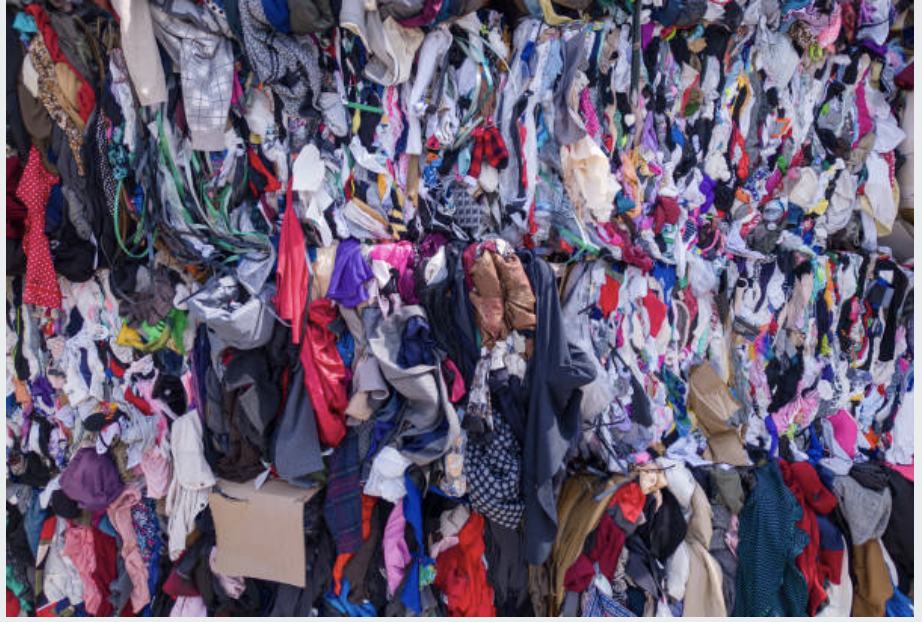
The average household credit card debt in the US is over $14,000. The ability to buy large amounts of cheap clothing doesn’t help these statistics, and makes it easier to form ‘addictive’ shopping habits that give a short-lasting dopamine rush with every purchase. Shopping has become a way for many to cope with depression, anxiety or even sheer boredom.
Then there’s the FOMO effect. Not being up to date with the latest trends, creating an inferiority complex, and the feeling that your wardrobe will never be ‘complete’. Fast fashion brands want customers to keep coming back, always looking for the next new thing.
Are there any advantages to fast fashion?
The fast fashion industry has created a lot of negatives. One advantage, however, is that it has made clothes more accessible and more affordable in the short term.
If you’re unemployed, or a student going for your first job, a new suit to attend an interview is not out of reach.
The cost to families of keeping ever-growing children in clothes is less, and purchases for specific activities like sports kits are more affordable.
Of course, this advantage is only realized provided that the lure of shopping at volume can be avoided. A hard thing to avoid when you have billions of dollars worth of advertising calling to you.
How do you know if a brand is fast fashion?
The clothing industry is an incredibly complex network of global supply chains and is very opaque, making it difficult to make good consumer choices.
Brands are often supplied by third party manufacturers, who in turn source their products from a separate supplier. Practices are hard to verify and ensure that they are maintained. The life cycle assessment of clothing, which is the complete end-to-end environmental impact of a product, is challenging even for scientists to estimate.

As a consumer, it’s even more difficult to know whether a brand is selling fast fashion. The cost of clothing is not always a true indication of quality or of ethical practices. Companies also know that environmental and social impacts are increasingly becoming a key consideration for purchases, and are keen to tap into the conscientious consumer market.
The problem is that not all positive connotations that are implied in marketing campaigns are actually delivered on, a practice known as ‘greenwashing’.
So what should you look out for?
Firstly, check the material that garments are made from. Some textiles, such as organic cotton and organic hemp will have less environmental impact than those at the other end of the spectrum, such as Rayon, polyester and acrylic.
Next, look to see if the brand has any certifications or accreditations, such as the Global Organic Textile Standard (GOTS) and the OEKO-TEX standard. For social concerns, you can look for Fair Trade certification and members of the Transparency Pledge, which commits companies to sharing the names and locations, product types and number of workers in all of its factories.
Finally, if you really want to understand where your clothes are coming from, reach out to the company and ask the question.
How to avoid fast fashion when shopping.
The first thing that you can do is to avoid overconsumption in the first place. Slow down your purchases, and the time it takes to make these purchases. Make sure you are buying items that you actually need, you know you will use, and that you know fit you.
In terms of your day-to-day fashion, figure out your ‘uniform’ – a look that suits you and your lifestyle – and buy clothes that are variations on it. This reduces the urge to be pulled into every micro-trend, and builds a wardrobe that is full of items that you look good in and will actually wear.

If you do need to make a clothing purchase, try to invest in quality items that are more durable and consider spending extra on brands that align with your values. This might mean spending some time researching which companies this applies to, but this also helps slow down the process.
Consider whether the clothes that you buy need to be brand new. It might be less convenient, but you might find what you’re looking for in a second-hand store. You might even think about renting clothes, particularly statement pieces like handbags, or one-off items that you might wear for a formal occasion.
Make intentional purchases.
It might feel like fast fashion is everywhere, but there are companies that are trying to make a change for good. The best thing that you can do to support them is to vote with your dollar and make intentional purchases. As awareness grows, alternative options are becoming much more mainstream and it’s easier to say no to fast fashion.

